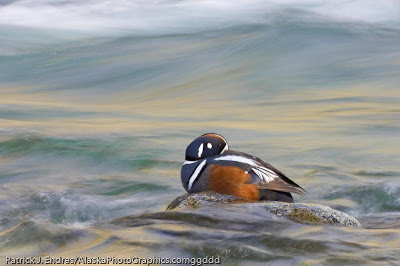 Male Harlequin duck resting on rocks, headwaters of the Gulkana river, interior, Alaska.
Male Harlequin duck resting on rocks, headwaters of the Gulkana river, interior, Alaska.Canon 1Ds Mark III, 500mm f4L w/1.4x, 1/2 sec @f45, ISO 100
Harlequin duck males are colorful birds with distinct markings. They favor fast moving water for feeding and can often be found resting on rocks along stream shores. They are attentive birds and apart from a blind, require a slow and incremental approach. For this photo session, small patches of clouds, shade and shadows required constant exposure adjustments since the white parts of the duck’s plumage get overexposed in sunlight. After some decent preliminary shots, I began experimenting with longer shutter speeds to blur the moving water.
This can be technically challenging with a super telephoto lens, since the smallest vibration during the long exposure may cause a blur if not executed correctly. I used an appropriately strong tripod and ballhead, and set the camera on mirror lock up, with a 2 second delayed shutter release to prevent this. But, the birds move ever so slightly also, and they blink too, so I’ve learned to shoot many frames just to be safe. It was late enough in the evening to get a little reflective yellow color from the clouds, which contrasts well with the aqua blue of the mountain water.
I think the photo of the duck alone is a good image, but the creative challenge presents itself always: how to take a good image and make it unique—make it interesting—make it better. In this case, I think the blur in the water helps in two ways:
- It creates a sense of movement to an otherwise static scene presenting a contrast between the stillness of the duck and the fluid, moving scene in which it lives.
- It helps isolate the subject by softening the background and thereby creating an easy visual separation against the subject.






